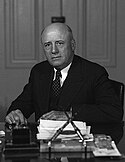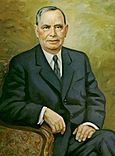United States House election, 1942
|
|
||||||||||||||||||||||||||||||||||||||||||||||||||||||||||||||||||||||||||
|---|---|---|---|---|---|---|---|---|---|---|---|---|---|---|---|---|---|---|---|---|---|---|---|---|---|---|---|---|---|---|---|---|---|---|---|---|---|---|---|---|---|---|---|---|---|---|---|---|---|---|---|---|---|---|---|---|---|---|---|---|---|---|---|---|---|---|---|---|---|---|---|---|---|---|
|
||||||||||||||||||||||||||||||||||||||||||||||||||||||||||||||||||||||||||
|
All 435 seats to the United States House of Representatives 218 seats needed for a majority |
||||||||||||||||||||||||||||||||||||||||||||||||||||||||||||||||||||||||||
|
||||||||||||||||||||||||||||||||||||||||||||||||||||||||||||||||||||||||||
|
||||||||||||||||||||||||||||||||||||||||||||||||||||||||||||||||||||||||||
The 1942 United States House of Representatives elections was held in the middle of President Franklin Delano Roosevelt's third term.
The main factor that led to the Republican gains during this election cycle was concern over World War II and American involvement.
Roosevelt's Democratic Party lost 45 seats, retaining only a slender majority even though they lost the popular vote by over 1 million votes (3.9%). This would not occur again until 1952, when the party who won the popular vote did not also win the majority of the House of Representatives.
Source: Election Statistics - Office of the Clerk
Some special elections were held on dates other than in November.
Source: Election Statistics - Office of the Clerk
Arizona received a second representative in reapportionment; it continued to elect both representatives at large rather than drawing districts.
Three new seats were added in reapportionment, increasing the delegation from 20 to 23 seats. Two of the new seats were won by Democrats, one by a Republican. One Republican and one Democratic incumbents lost re-election, and one vacancy was won by a Republican. Therefore, both Democrats and Republicans increased by 2 seats.
Florida received a 6th seat in reapportionment; it added an at-large district to its 5 districts rather than redrawing them.
Illinois was reapportioned from 27 representatives to 26; it went from electing 2 at-large representatives to 1 without redrawing the other districts.
Indiana was redrawn from 12 districts to 11 after reapportionment; most of the districts underwent minor boundary changes, and the old 11th district was divided up, distributing Madison County to the 5th, Hancock County to the 10th, and consolidating the parts of Marion County in the old 11th and Indianapolis-based 12th into a new 11th. This forced incumbents William H. Larrabee and Raymond S. Springer to run against each other in a district drawn mainly from Springer's old district.
...
Wikipedia


